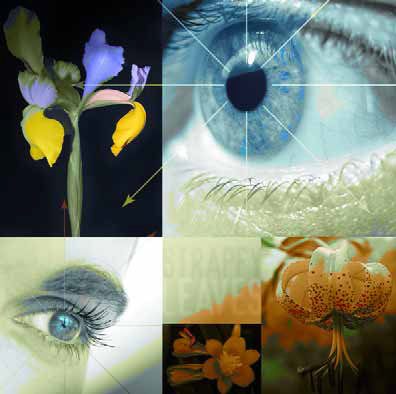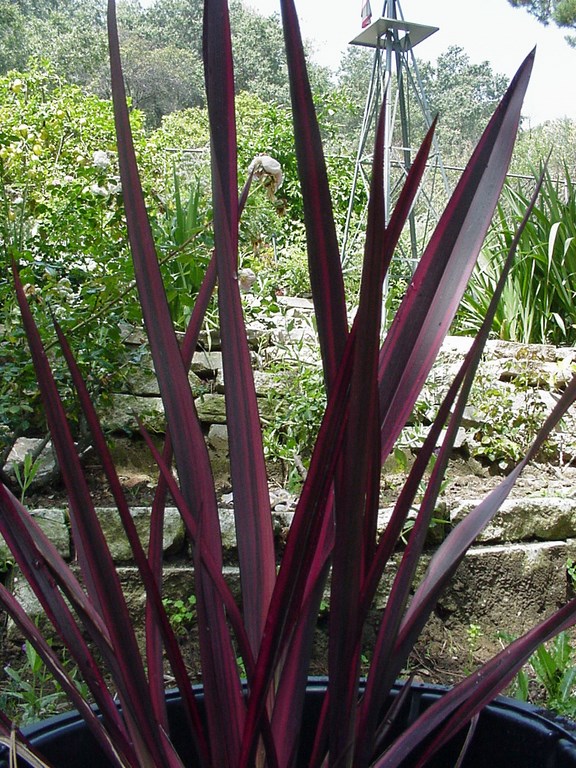Feeling Strapped

Most of my clients don’t know a Pittosporum from a Loropetalum – nor would I expect them to.
Unfortunately, however, this often leaves me to describe plants to them, a process that often makes me feel like I’m reenacting that television commercial where the homeowner tries to mimic the creature seen crawling across the kitchen floor for an exterminator: I’ll stand there with my arms up or out, attempting to look like the botanical specimen I’m suggesting for use in their garden.
One of the easiest groups of plants to describe in this or any other way is a collection I call the strappy-leaf plants. I didn’t make up the term, and I’m sure many of you have also used it yourselves to describe plants with foliage that looks like straps – generally long strips that emerge from a central clump and arc up, sometimes flopping over to create an upright or fountain-shaped structure.
These plants come in all shapes and sizes, with leaves ranging from narrow to wide and long to short. As a group, they are among the most important plant forms I use in any of my designs.
DESIGN SENSE
I value the strappy-leaf plants for a number of reasons: They add texture to any design, break up otherwise flat plant planes and can also be used to lead the eye in various directions. But perhaps most important in the current context, these plants are great alongside watershapes: Look at almost any stream or pond – whether in nature or in a backyard – and you will surely find one strappy-leaf plant or another at the water’s edge.
The effect of these plants is strongly visual and occurs on several functional levels. Even something as small as a ‘Jack Sprat’ Flax or Liriope, for example, may guide the eye of the beholder to a plant behind it. By contrast, if the strappy-leaf plant has an arcing or “weeping” form, it may be used to attract attention to a plant in front of it – or point to some other focal point, such as a well-placed garden statue.
Lines of any kind in any design direct the viewer’s eye. When those lines are vertical (as we often see with stappy-leaf plants), they guide the eye up or down and can be used to bring visual energy to a setting. In addition, simply by placing strappy-leaf plants next to mounding plants or in front of larger plants or behind boulders, you can create contrasts and/or highlight certain spots relative to the rest of a planting.
The larger the strappy-leaf plant, the more overt is the eye guidance. Take a flat wall, for example, and place a big Phormium tenax (commonly known as Flax) in front of it: The plant will guide the eye up to a detail at the top of or high on the wall or beyond to a distant view – or simply break up the flat wall and give the visual plane some depth. If the wall is low, such a plant can draw the eye up and make the space feel “taller.” The larger the plant, the more emphasis, power and dominance it will have.
These plants also can be used to provide visual breaks. In a flat field of ferns or other fine- or medium-textured plants, for example, strappy-leaf plants serve well in breaking up long expanses or leading the eye up at designated intervals along the visual plane. Or in the case of a long wall with evenly spaced pillars, the verticality of Flax or one of the larger varieties of Agapanthus might be used to emphasize the cap on the pillar by guiding the eye to that spot. If the cap is unadorned, perhaps the visual guidance refers to a planter, statue or some other garden accessory that needs to be accentuated within a design.
One of my favorite uses of these plants is all about water: The same way stones are used to suggest flowing water in Asian-style landscapes, the arcing forms of strappy-leaf plants can be used to invoke waterspouts, water in a fountain or some other watershape that shoots up in the air. I’ve even combined the two, interplanting fields of stone with strappy-leaf plants to suggest a pond with waterspouts.
PLANT PREFERENCES
This truly is a case where design possibilities are limited only by creativity and imagination. It’s also a relatively rare case where geography is not so great a factor, as these concepts can be translated to any strappy-leaf plants that grow in your area.
Here are a few specific plants that have worked well for me. I’m confident your local nurseries will have varieties that can work as reasonable facsimiles for my selections, keeping in mind that the most important factors to consider are the sun/shade tolerances and mature sizes of the plants you’re considering.
[ ] Agapanthus (Lily of the Nile). With its slightly arcing form, this highly versatile plant has probably been over-used in southern California. It is quite hardy, requires little or no maintenance, comes in many sizes, can grow in the sun or shade and will live virtually forever, all of which explains its extensive use in commercial installations. If those are your plant-selection criteria, I’d recommend tweaking your design by finding varieties with either dark blue or white flowers so that your client’s garden has something a little different from everyone else’s.
 [ ] Clivia miniata. This staple of the shaded garden is similar in appearance to Agapanthus, but its leaves are almost twice as wide at maturity. It will grow and produce beautiful flowers in darker spots than will either Liriope or Agapanthus. Hybrid versions in yellow offer some relief from the traditional orange (usually the least-desired color in the spectrum) and make these plants more usable. A slight warning: At this point, the yellow-flowered varieties sell at a significant premium above their orange counterparts – as much as ten times at nurseries I frequent.
[ ] Clivia miniata. This staple of the shaded garden is similar in appearance to Agapanthus, but its leaves are almost twice as wide at maturity. It will grow and produce beautiful flowers in darker spots than will either Liriope or Agapanthus. Hybrid versions in yellow offer some relief from the traditional orange (usually the least-desired color in the spectrum) and make these plants more usable. A slight warning: At this point, the yellow-flowered varieties sell at a significant premium above their orange counterparts – as much as ten times at nurseries I frequent.


[ ] Iris. There are so many varieties of Iris that entire books have been devoted to them. Suffice it to say they have found homes next to many watershapes, whether simulated or real, and are particularly prominent in Asian-style designs. The most common flower colors are blue or lavender, but it’s reached a point among growers where almost the entire spectrum is now covered.
[ ] Liriope (Lily Turf). Liriope is slightly more upright than Agapanthus and has narrower leaves. It comes in regular- and giant-size varieties that range from 18 inches to about three to four feet high and wide. I particularly like Liriope spicata ‘Silver Dragon,’ a variegated white variety that works in shady spots to create the illusion of light and can be used to break up shady designs that feature the finer textures of ferns or coarser large-leaf textures. The white variegation also offers a strong contrast against the darker greens that often thrive in shady environments.

 Hybridizers have made great strides in the past decade with these plants, offering selections of various sizes and colors (including white, yellow, pink, orange, red, burgundy, bronze and a large range of greens). There’s one for almost any design, and backlighting these plants can further enhance their visual appeal in a nightscape.
Hybridizers have made great strides in the past decade with these plants, offering selections of various sizes and colors (including white, yellow, pink, orange, red, burgundy, bronze and a large range of greens). There’s one for almost any design, and backlighting these plants can further enhance their visual appeal in a nightscape.
IN THE GARDEN
Once you’ve incorporated any of these plants in your designs, it’s important to remember that, although they are quite self-maintaining in most cases, they do require annual cleanout.
To that end, I suggest to my clients that they should never let their gardeners cut them back to the ground or chop off the ends of sunburned leaves. For the best appearance and the health of the plant, I instead suggest having the gardener remove any individual leaves that have wilted or burned by cutting them off at the base.
There is nothing more unattractive in a garden than a strappy-leaf plant that has been leveled to within an inch or two of the ground. It’s just not necessary where a little extra care and a marginal expense will keep them looking good year-round.
Stephanie Rose wrote her Natural Companions column for WaterShapes for eight years and also served as editor of LandShapes magazine. She may be reached at [email protected].











